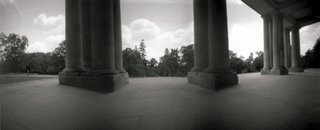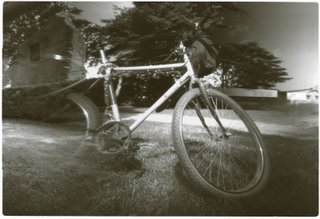

My pinhole on blinding camera
panoramas and transition effects on a cylindrical surface
The original idea this camera was a 360-degree panorama. Dieter Bublitz has to his pinhole camera page a drawing that describes the project, and with further research on the web you come across similar constructions that have been partially completed. For all cameras are more apertures (3-8) needed a kind of Panorama expose.



My design is limited after several attempts to only one aperture: it turned the camera after the roll film was exposed and transported. This process is very similar to the approach for panoramic images, which are assembled by stitching technique. However, the fading will take place in the camera, not behind the software.
The schematic drawing (top left) illustrates the principle of Dieter's construction. In addition, my simplified version. In the version I have converted a 9 x 12 sheet film cassette for roll film cassette, which I use in my under large-format camera , The spools are made within this halved the cylinder. To download the movie easily, the inner part is removed (bottom photo), here with inserted test film.

The upper Panorama (Courtyard, Castle Hohenheim) you can clearly see the weaknesses these complex constructions: in the overlapping areas of dark stripes occur. Slightly less at the lower falls on this panorama of the columns, and I have tried each of the center of the exposure to place between the columns.
Upper Panorama: 5 exposures on roll film, lower Panorama: 3 exposures on roll film.

If you do not take turns in 60 degree increments exposed, but more or less arbitrary motifs sequentially receives, photographs created as above: front pushed left an exposure of the memorial stone in the middle of the bicycle and the third exposure the right is taken up again in another place.